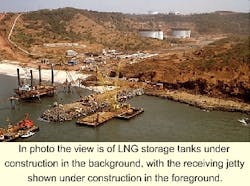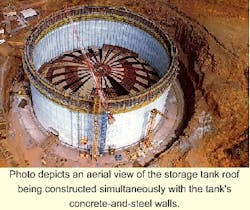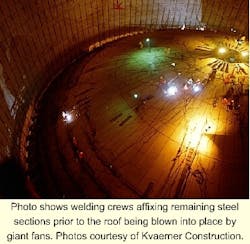A novel approach has been employed in construction of one of the world's biggest LNG storage tanks, part of the Dabhol LNG power project that is India's first.
Kvaerner Construction Group Ltd., Rickmansworth, UK, and affiliate Kvaerner E&C, claimed a construction record for the LNG market in constructing the Dabhol storage tank roof inside the tank. Dabhol is a remote area in Maharashra state on the west coast of India south of Mumbai.
The Enron International subsidiary of Enron Corp. in 1992 launched efforts to develop an LNG and 2,140-Mw natural-gas fired power plant project at Dabhol. The Dabhol project is divided into two phases. The first phase involves a 740-Mw, variable-fuel plant, initially fired by naphtha; the second will involve 1,400 Mw of capacity, fired by natural gas imported as LNG. When the second phase is commissioned in late 2001, the entire plant will use natural gas as fuel. The two phases will require about 2.3 million tonnes/year of LNG feed.
The firms comprising the Dabhol Power Co. (DPC) consortium have already secured most of the necessary contract LNG supplies for the megaproject, from Oman and Abu Dhabi.
Eight years ago, the launch of the Dabhol project was seen as a litmus test for foreign investment in India's energy sector. After a great deal of difficulty-mostly incurred by political wrangling at the local level-the first phase of the Dabhol project started up in June 1999. That same month, Enron closed $1.87 billion in financing for the second, much-larger phase of the project (OGJ, June 14, 1999, p. 34).
Dabhol Power's first phase is owned by Enron, 50%; the Maharashtra State Electricity Board, 30%; and Bechtel Enterprises Holdings Inc. and GE Capital Structured Finance Group, 10% each. Enron will own 80% of Phase 2, and Bechtel and GE, 10% each.
(The latest details on this project are covered in a related article that begins on p. 62.)
Project details
Kvaerner's contract for the $278 million turnkey project calls for it to supply, construct, and equip facilities to offload LNG from vessels in 2160° C. liquid form, pipe it to a storage center for eventual regasification, and then move the reconstituted gas to the power plant. Enron affiliates are managing construction of the LNG facilities for DPC.
Kvaerner was charged with:
- Outfitting a new LNG offloading jetty with automated LNG unloading arms.
- Installing insulated supply pipelines that extend 2 km from the jetty-head to a storage and processing area closer to the power plant.
- Building an LNG storage and processing area consisting of three concrete and steel insulated storage tanks, each with capacity of 160,000 cu m, as well as regasification and pumping process facilities to feed the new power plant.
Kvaerner is building the first three of six planned LNG storage tanks it believes will be the world's biggest. They are being built at three levels into a hillside in a narrow, rocky valley surrounded by 100-m-high cliffs.
The remoteness of the Dabhol fishing region in southwestern Maharashtra state is such that almost all equipment and supplies must be imported, and all personnel must be transported by helicopter. About 80% of materials and equipment for the project has been shipped in from Europe, Japan, and the US-notably specialized LNG equipment such as pumps, pipe supports, bellows, vaporizers, and boil-off gas condensers.
According to Roy Isden, Kvaerner project director and newly appointed general manager of Kvaerner's LNG business unit, "The construction and process engineering is straightforward-it's the logistics that is the key to the success of the job."
Novel construction
Kvaerner claimed a new construction record for the international LNG market by building the Dabhol tank roof inside the tank base while its walls were being simultaneously constructed.
The schedule for completing a Dabhol tank-with it fully closed off and insulated-was set at less than 30 months, vs. the industry standard of 33-36 months.
"If we meet program-and I think we should-it will be the fastest construction time anywhere for this kind of structure," Isden said.
Kvaerner undertook the simultaneous approach on constructing the tank roof and walls because Kvaerner wanted to ensure that the tank's outer shell was completed before the start of the monsoon season.
The 770-tonne steel roof, which measures 80 m in diameter and 14 m high and was built from 600 separate steel sections, was lifted into place without benefit of the massive cranes usually employed for such a job. Because such giant cranes could not be used, Kvaerner opted to use two giant fans to blow the tank 40 m into position. This process took 7 hr, with each fan producing 900 cfm of air.
Thereafter, Kvaerner was to begin work during the rainy season on internal facilities for the tanks. This includes installing a 1-m-wide layer of expanded perlite insulation between the outer wall and an inner steel casing.
A suspended deck under the roof of each tank will contain a 1-m-thick blanket of fiberglass insulation. A layer of foam glass has already been installed beneath the base, with tank-base heating to prevent the surrounding ground from freezing.
The focus then shifts to process installation, where Kvaerner must cut and prepare 15 km of stainless steel pipework at the site. Everything connected to the LNG piperuns must be designed to be thermally insulated, including cold supports fixed into the ground.
Paul Emson, Kvaerner E&C project manager for processing, noted the difficulty of this stage of the work because sturdiness and good insulation aren't qualities readily found together: "Supports have to be a complex combination of steel and resin-based insulation barriers that have sufficient strength and rigidity."
Kvaerner faces still another logistical hurdle when it comes to hydrostatically testing the tanks, each of which will require at least 100,000 cu m of fresh water. Capturing fresh-water volumes that large presents a problem, because, despite the annual deluge during monsoon season, there is no local reservoir capable of holding such volumes.
"The original plan was to draw off from the firefighting system, but this is now impossible," Isden said. "At this moment, we have no way to draw off and store this amount of waterellipseIt's simply one more logistical problem we have to solve."
The construction project is expected to be completed in about 2 years.





